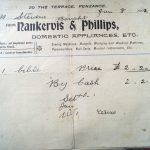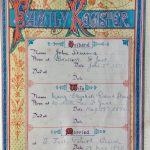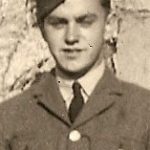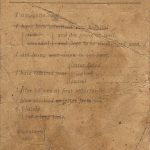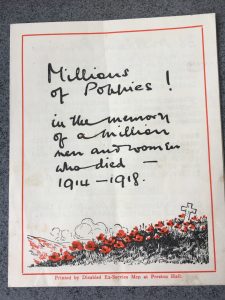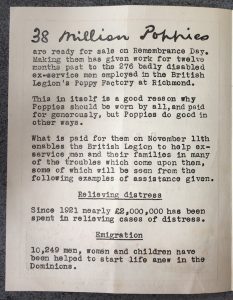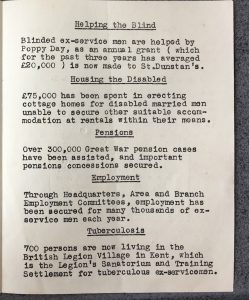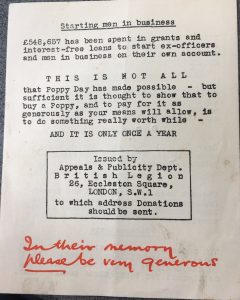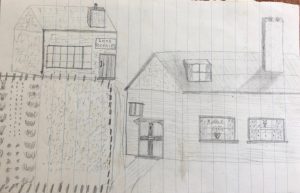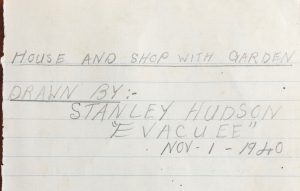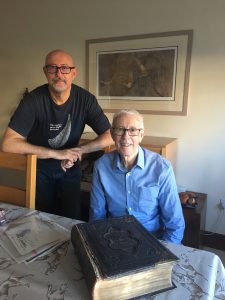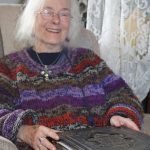A century of stories of lives lived in a found family Bible
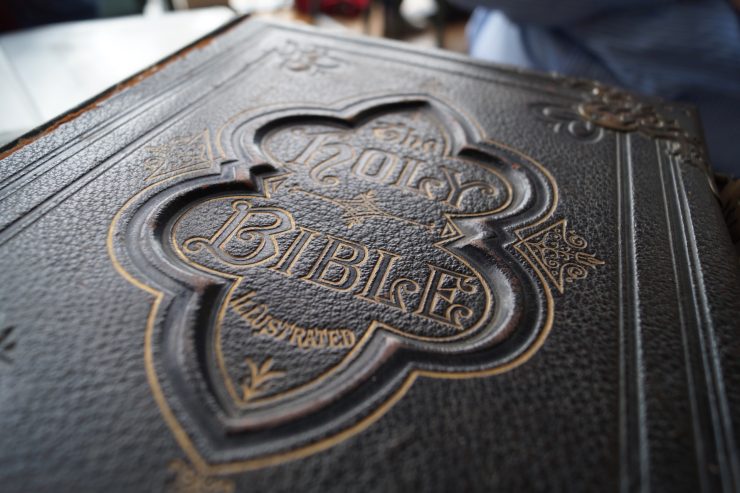 A lost, or rather found, Bible started a poignant journey of imaginings, history and heroism. Very large and very old, the Family Bible was filled with personal notes, letters, drawings, photographs and snapshots of lives lived and died. It was discovered in a house-clearance and passed on to Revd Karsten Wedgewood, based in Pendeen, who made an appeal in the parish newsletter to reunite the Bible with family members.
A lost, or rather found, Bible started a poignant journey of imaginings, history and heroism. Very large and very old, the Family Bible was filled with personal notes, letters, drawings, photographs and snapshots of lives lived and died. It was discovered in a house-clearance and passed on to Revd Karsten Wedgewood, based in Pendeen, who made an appeal in the parish newsletter to reunite the Bible with family members.
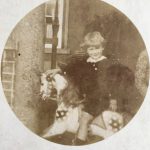
A photo found in the Family Bible
This piqued the interest of Kelly Rowe, the Diocesan Head of Communications, and Revd Barbara Prowse, a retired vicar living in the parish. And so began the quest to reunite the this precious family heirloom with the descendants of John and Mary Stevens who, according to a receipt tucked away in its pages, bought the Bible in 1902 for two pounds and two shillings.
Quest to reunite the family with their Bible
John Stevens was born in Botallack, St Just, in 1871. Mary (neé Richards Thomas) was also from St Just; born in 1874, christened and married to John there in 1898. They had three children, John, known as Jack, Maud and Mary. The two oldest were born in Carn Bosavern, a hamlet of only a handful of houses, one of which Barbara not only lives in today, but whose garden runs adjacent to the house where the children were born. “That was enough for me,” says Barbara. “I knew I had to pursue this and find the family!”
A postcard from WWI
The Bible held a faded Field Service Postcard, sent during WWI to John Stevens, dated June 1916, confirming only that the sender was “quite well” and that a letter would follow. The official postcard stated in no uncertain terms that if any additional information was included, the card would be destroyed. The signature is too faded to read but who was the sender? Very possibly it would have been John’s only son, Jack, who would have been just 16 years old at the time.
- Receipt for the Family Bible
- A family record
- A young Jack Stevens who went off to war
- A postcard from Jack during WWI
Jack survived the war and, with sister Maud, remained in Cornwall. The third child, Mary Elizabeth, spread her wings and emigrated to America to marry Sydney Branwell. Notes and cuttings suggested they met in Cornwall but that Sydney wanted to make a new life in America. Mary followed and, as a New York newspaper cutting proclaimed, they were married as soon as she stepped off the ship in 1925.
Family news that takes months to travel
A letter in the Bible from Mary Elizabeth to her parents told the sad tale of the sudden death of a relative. It’s hard to imagine in these days of instant communication that news of a major event would take weeks to travel, or how it would feel to open the post and discover someone you loved had died. Mary mentioned their two children, Evelyn and baby Jack, a significant name as was discovered later.
By looking at old shipping records, Barbara discovered the family returned and it appears the Branwell children settled in St Just, Cornwall, where they grew up to meet and marry their partners and have children of their own. Evelyn married Theodore Taylor having one son, Jerome, then later, after the death of Theodore, married Jimmy Taylor having two more children, Mandy and Stephen. Jack married Laura Alice Gray, known as Alice, and they had two children Christopher and Linda.
A thank you from the front and an early poppy appeal
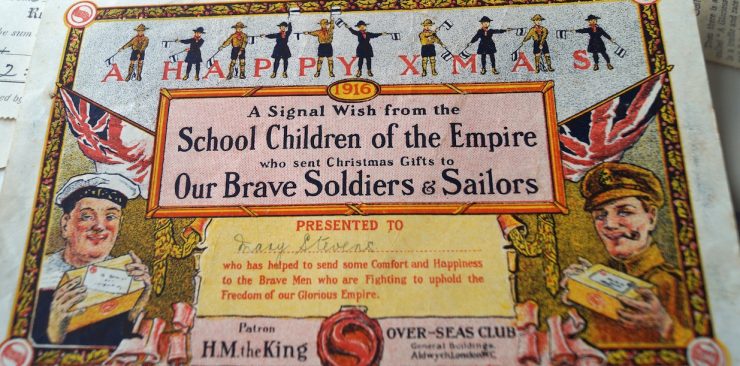
Treasures in the Family Bible included a ‘Signal Wish from the School Children of the Empire.’ It was presented to the young Mary Stevens as a thank you for sending gifts to the soldiers on the frontline during WWI. There was also a very early poppy appeal, making it known that 38 million poppies had been made by ‘the 276 badly disabled ex-servicemen’ helping to raise over £2million since 1921 to ‘help ex-servicemen and their families in any of the troubles that come upon them.’
Helping ex-servicemen and their families in any of the troubles that come upon them.’
World War II and the arrival of an evacuee
Time marches on within the pages of the Bible and as the Great War became WWI when WWII broke out, it seems like the family took in an evacuee. Keepsakes, like war-time shopping lists, ribbons and pressed flowers, also included some child-like drawings. One had pencilled across the back, “House and shop with garden, drawn by Stanley Hudson, Evacuee November 1, 1940.”
All of which was fascinating but wasn’t finding any living relatives to pass the Bible on to. “I could only go so far on the family-tree websites that I had subscribed to,” says Barbara. “Data protection prevented me from researching anyone alive.”
The unexpected value of Facebook
That’s where Kelly and Facebook came into their own. Both Barbara and Kelly decided that the second child of John and Mary Stevens, Maud, who married Jim Trezise in 1929, would be a good line to follow. The couple had six children, all of whom married and had their own children in and around Penzance. And Trezise seemed an unusual name that hopefully wouldn’t bring up too many possibilities on Facebook.
And that is how Kelly managed to track down Gareth Trezise, grandson of Maud and Jim and great grandson of Mary and John Stevens. Gareth was a little hesitant when contacted by the Diocese and told they had something that he might be interested in!
Gareth & Haydn Trezise reunited with their Family Bible
“I was a bit taken-aback,” laughs Gareth. “But thrilled when I realised what had been found. I’m so grateful for the research that’s been done to find us – this Family Bible is very special.”
“I was a bit taken-aback,” laughs Gareth. “But thrilled when I realised what had been found. I’m so grateful for the research that’s been done to find us – this Family Bible is very special.” When it was handed over to Gareth, a wild-life photographer who lives near Bristol, his father William Haydn, known as Haydn, was there to shed some light on some of the half-stories that the Bible hinted at.
A father’s love during the Levant Mine tragedy
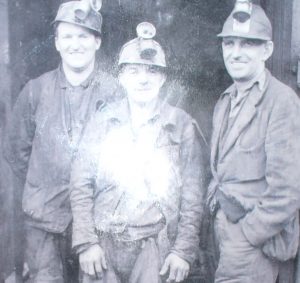
Sydney Bramwell, middle, with Johnny Stevens
Haydn spoke of a mining disaster at Levant Mine in 1919. He understood that his uncle, Sydney Branwell, had been saved from certain death when the man-engine carrying the miners up and down the shaft, collapsed. Sydney’s father, Peter, threw himself over his son to protect him from worst of the impact and the falling debris. Sadly, Peter died, aged only 58, together with his brother, Thomas Branwell, aged 60. Sydney was only 19 at the time and lived with the pain of his injuries all his life. A good reason, perhaps, to make a new life in America.
Another member of the extended family was also working at Levant Mine, but not on that fateful shift. It was Jack, the likely sender of the postcard from WWI. He sadly died in 1956 and Haydn was at his bedside at the time, “He died of cancer, no doubt brought on by the fumes and inhalation of the mines – there was no health and safety back then.” Sydney and his brother-in-law were close, as the photo of them together shows, a good reason, perhaps, to name his only son Jack.
Linking the past with the present
It’s a curious mix of feelings to read and touch another family’s keepsakes – uncomfortable for the intrusion, humbling to learn of lives lived and captivating to have a glimpse into the past.
As Kelly says and Barbara agrees, “It’s been a privilege to try to link past and present. We’re really happy to have reunited the Family Bible with the Trezise family and feel sure that John and Mary would have approved!”
Revd Barbara Prowse
“It’s been a privilege to try to link past and present. We’re really happy to have reunited the Family Bible with the Trezise family and feel sure that John and Mary would have approved!”
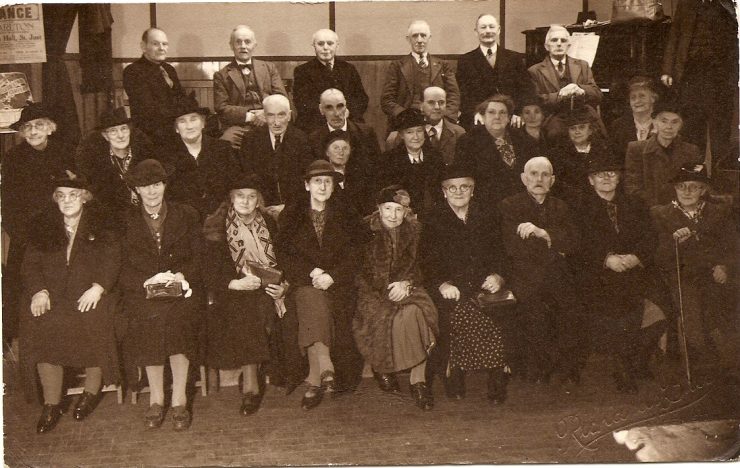
John Stevens, the original owner of the Family Bible is third from the right on the bottom row
Written by Jac Smith
